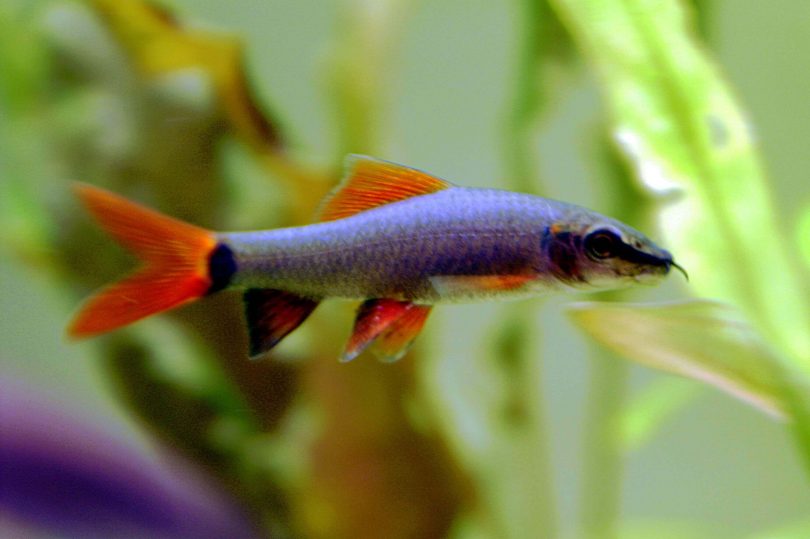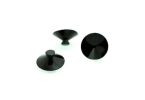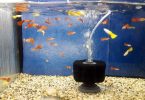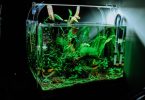Table of Contents
Rainbow Sharks
Growing up, I had the opportunity of watching so many animations about humans, reptiles, pets, animals, robots, and animations about aliens and the universe in general.
Some were filled with humour and cracked me up that I laughed so much, others were too emotional and I had to hold myself back each time I remember it was just a cartoon.
However, I learnt a lot through animations which is why I am telling you about them in this introductory section.
In most of the aquatic animals’ animation I have watched, the dolphin has been posited as a very human friendly fish, always ready to come to human aid.
On the other hand, the shark has been presented as a very harmful fish, so carnivorous, feeds on even human, and also kills any dolphin that tries to save humans from the fresh water or the sea.
Whether all of these are true or false, is something I barely think of, in fact, I do not bother myself about that until I am in a situation that needs verification.
More so, I have read a lot about rainbows from the holy book of the Christians, and from animations as well.
The rainbow apparently is a sign of hope, and a promise that flood or rain will never again be used to destroy the world. Hence the rainbow is a very beautiful thing with very bright colours; seven of them.
Paradoxically, with what I have come to know about sharks as well as rainbow, attaching the promising rainbow to the very fierce and “supposed” carnivorous shark is a pair I wish I can unknot. I guess you felt the same way when you first heard about “rainbow shark”.
Do not worry, it is a situation we cannot change, but we can learn about the rainbow shark to our own advantage and see how we can deal with it should we ever be stuck with fighting to escape a rainbow shark, or rearing a rainbow shark for commercial purposes or any other reason at all.
So, in this article the succeeding sections will show us all we need to know about the “Rainbow Shark”.
THE BODILY FEATURES OF A RAINBOW SHARK
The first time I heard of a rainbow shark, after my skepticism about it, I imagined it was going to be streamlined like all sharks and fishes are in general, but that its fins, tail, mouth, eyes, and scales will all be the colours of the rainbow (you can laugh about that, I bet you felt the same way too).
Now that I know a lot about rainbow sharks, I will not relieve you of the suspense you feel on the truth of the rainbow shark’s appearance, so read thoroughly to see if your imaginations and animations are anywhere close to the reality of the physical appearance of a rainbow shark.
What exactly does a rainbow shark look like?
The first striking thing about the body of a rainbow shark is its very long black, bright blue or dark body, it is streamlined and longer that most fishes so the body is striking that you will not mistake it for any other fish.
The protruding nose and mouth, or the snout (as it is called in biology) is pointed and well defined.
The rainbow shark’s fins have dual colour blend; orange-red colour and the red colour that glitters in the water as the fish swims.
More so, the straight-line area from the mouth up to the eye and gill area have tiny stripes with variant colours depending on the type of rainbow shark. The tail fins are also coloured in variance.
However, female rainbow sharks are bigger than male rainbow sharks who have black lines close to their tail fins, are in thinner bodies but are usually few inches longer than the female rainbow sharks.
WHERE YOU CAN FIND THE RAINBOW SHARK?
First, it is important to know that the rainbow shark is an aquatic mammal in the Animalia kingdom, belonging to the chordata group of phylum, it falls under the class of Actinopterygii, and belongs to the order of Cypriniformes, in the family of Cyprinidae.
Genus is Epalzeorhynchos and the species is E.Frenatum, which gives rainbow shark the botanical name epalzeorhynchos frenatum.
Being a non-cartilaginous fish, the rainbow shark inhabits in freshwater; predominantly in Thailand, Southeast Asia.
They inhabit Mae klong, Mekong, and Chao Praya river basins because of the sandy substrates that avails the bottom feeders with suitable grazing spots.
During the wet season, they migrate to flooded areas, and once the dry season comes calling, they often roll back to their natural habitat for the rest of the season or year.
BASIC FACTS ABOUT THE RAINBOW FISH
BEHAVIOUR:
Rainbow sharks are aggressive sharks, not too aggressive though. As middle level and bottom level dwellers, rainbow sharks feed on left over fish food that sink in the fresh water, as well as the algae that grows on the surface of the water because they are aquarium-surface and tank bottom cleaners.
Rainbow sharks are quite territorial in nature, once they are large in size or as they age in their life cycle, they begin to mark territories for themselves.
While marking territories, the large rainbow shark practically drives the small rainbow shark away; it chases it until it either dies, or leaves the territory.
This usually happened when the rainbow sharks are in confined environments. While in the wild, the rainbow shark regardless of its size does not attack its own kind, but is very aggressive with other kinds of fishes; another territory marking scheme.
The rainbow sharks fighting style involves head clashing, tail butting, and also biting, the level of aggression displayed by the clashing sharks could result in one jumping off the tank, if not two of the rainbow sharks involved in a fight.
To control the aggression or this type of behavior in rainbow sharks, decorative ornaments like plants, tunnel and cave like ornament should be put in the tank.
More so, the rainbow sharks should not be put in the same space with the likes of bala sharks, black sharks, and red-tailed sharks, as they will check and attack them as well.
HARMONY OR COMPATIBILITY
Humans while seeking company look out for compatibility, so as to coexist in great harmony with each other as well as build alliances against future adversaries.
In like manner, the rainbow shark also needs company, and even though it appears to be given to violence, and is very aggressive, the rainbow shark also can live or exist in harmony but it all rests on compatibility.
So, if you are an aquarist, whether you are just getting started in the aquarium kingdom, or that you have been in the field that your level of expertise is almost equivalent to a PhD, this section will show you all need to know about the compatibility of the rainbow shark.
The rainbow sharks can live with gouramis, danios (giant danio and zebra danio), rasboras, loaches (clown loach, yo-yo loach, and zebra loach), and plecos; and are very compatible with rainbowfish (Melanotaenia boesemani or boesemani rainbow fish, and neom rainbow fish or melanotaenia praecox), and barbs (Puntius titteya or cherry barb, and Pethia conchonius or rosy barb), which are upper tank and middle tank dwellers.
However, rainbow sharks are very intolerable to smaller fishes, hence they are not compatible as they drive them out of the territory in no time just like bullies do around their “supposed” subjects.
Finally, it is important to know that the rainbow sharks prefer to be alone and are not very excited to even have their specie in the same aquarium, or as tank mates.
BREEDING
Continuity is necessary for any living thing at all, hence reproduction is necessary, either sexual (mating), or asexual as is seen with plants.
Rainbow Sharks like most mammals are egg layers. Although they are egg layers, and a few aquarists have affirmed seeing their rainbow sharks breed or spawn in aquarium, no fry has been reported to have been reproduced from that spawn because having them breed in an aquarium setting can really be difficult as the puzzle is yet to be solved.
However, this is because the aquarium environment is really very different from the rainbow sharks natural or wild habitat.
Consequently, a large number of the rainbow sharks are bred in the commercial farms in Thailand, southeast Asia, and sometimes hormone treatments are usually required for this.
More so, among the rainbow sharks are species of selectively bred colours. Aquarists have observed that this often results in the lack of melanin pigment in the rainbow shark, that is albinism.
Some aquarists have through genetic modification reproduced about four colours of glowing rainbow sharks; these colours include the following blue, purple, orange, and green. Although they appear or seem to be artificial, they receive similar care just like the wild rainbow sharks.
RAINBOW SHARK AQUARIUM and TANK REQUIREMENTS
For a playful but aggressive fish like the rainbow sharks, I bet you know it will definitely have certain requirements.
Obviously aquatic animals love the water which is why they have the name that reflects water. This implies that the aquarium has to be filled with enough water, not to the brim of a tank so that the area the tank is kept is not messed up; about thirty gallons of water should be okay for an adult rainbow shark depending on the size of the Tank of which a length of about or between forty-eight and fifty inches, and on the size of the rainbow shark.
What is important is that the Tank needs to be big enough to give the shark all the space that it needs, and the water also needs to be enough for the rainbow shark, being a middle level, and a bottom level dweller its own natural habitat.
Apart from the quantity of the water, aquarists have also discovered that a specific water texture makes the Tank or the Aquarium more habitable for the rainbow shark fishes. These specific requirements in water texture are as follows:
- The hardness of the water should be maintained at about five dH, or between five to eleven dH as the case may be, it just should not be below five dH, nor above eleven dH.
- The water should be at a neutral pH level; that is between six pH to eight PH alkaline level. So, before a rainbow shark is sent to an aquarium, the alkaline level of the given water should be tested.
- Another important aspect of the water texture for a rainbow shark in an aquarium habitat is the temperature. The temperatures should be between twenty-four (24) degrees centigrade and twenty-seven degrees centigrade. Or it should be between the ranges of seventy-five degrees Fahrenheit and eighty-one degrees Fahrenheit.
Again, no shark of smaller should be put in this space because the rainbow shark will certainly attack the fish just to mark territory.
More so, decorative covers or objects will make the aquarium more habitable for the rainbow shark. In order to imitate the natural habitat, you can choose to make the aquarium a bit sandy by using different sizes of pebbles and boulders to create a sandy substrate; and if possible, adding some live plants that will not outgrow the tank should be considered.
The idea behind having live plants is to make the aquarium or the environment feel more secure in the new habitat because a rainbow shark is always happy and less aggressive in an environment it feels safe and secure.
The rainbow shark comes from a place where water flows constantly bearing dissolved oxygen, creating room for an exchange of oxygen in the aquarium should be considered while imitating the natural habitat.
To create that oxygen exchange, contact an expert to install an extra air stone and filter outlet that will point or that points to the surface of the water.
You can also acquire a mini power head to give the rainbow shark the feel of a flowing river in its new habitat.
While you must not imitate the natural habitat for the rainbow shark aquarium, consider providing the rainbow shark a dark and quite area to sleep in the aquarium.
Also use enough obstacles and demarcating channels to provide the rainbow sharks enough hiding places within the aquarium. Artificial tubes and caves can serve as good refuge for sleep and hiding place.
Meanwhile, if you notice that your rainbow shark spends more time on the surface, then you have to follow the steps in the preceding paragraph and create room for oxygen exchange because rainbow sharks are middle and bottom level dwellers so it must be seeking for oxygen to be spending more time on the surface level.
The Freshwater is always fresh because the current or wave sets the water in motion and keeps it flowing, hence chances are that the water is usually neat.
This simply means that rainbow shark will be intolerant in a bad or a low-quality water so maintenance of the aquarium is very necessary.
The water should be changed and tested at least weekly and before introducing a new species of fish to the rainbow sharks’ aquarium, the tank will have to be fully and thoroughly cycled for the sake of the rainbow shark that can be very sensitive.
RAINBOW SHARK DIET
In the introductory section I shared how I hated the species of fish called “sharks” for being carnivorous, you remember that right? Anyways, the species of fish called “rainbow shark” is in reality omnivores.
Being bottom level and middle level dwellers, rainbow sharks are equally bottom level feeders.
In the natural habitat, they will scour the bottom part of the water just to find any edible at all; they will also do the same when placed in aquarium so to avoid them hitting on the tank while searching for a morsel, you will have need to supplement the rainbow sharks diet with daily feedings.
You can get your revenge on mosquitoes by feeding rainbow sharks mosquito larvae, yes you can! Consider it to be their frozen food.
To add to that list of frozen foods, you can also serve the rainbow shark blood worms, black worms or set up a live food colony just like in the ecosystem.
Bearing in mind that the rainbow fishes are omnivores, add sinking pellet food, staple, meaty foods, spinach, zucchini, and other blanched vegetables to switch things up for the rainbow shark.
The rainbow shark loves to eat a variety of foods so you can as well introduce lights, extra powerful lights to grow algae or place submerged rocks under very strong lights for some days to switch things up; remember that the bottom level dwelling rainbow shark often swims to the surface to feed on algae while in the wild so you could give it that feel here.
CONCLUSION
Everything thing we have shared in this article can generally be called a rainbows shark care guide, from the compatibility or harmony or tank mates to the breeding, to the diet, to the tank required condition.
The Rainbow sharks are not the most difficult species of fish an aquarist can handle, but specific requirements like the one we shared above makes it a lot easier.







